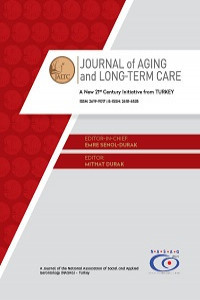Re-experiencing trajectories of posttraumatic stress disorder among older adults exposed to an exile
Re-experiencing trajectories of posttraumatic stress disorder among older adults exposed to an exile
One of the main symptoms in Posttraumatic Stress Disorder (PTSD) is re-experiencing the trauma (APA, American Psychiatric Association, DSM-5 Task Force, 2013), and studies have mentioned the effects of re-experiencing symptoms immediately after traumatic instances. Also, adverse psychological reactions of a traumatic event that occurred many years ago have not been extensively examined in the literature. In this respect, whether the content or frame of reexperiencing trauma symptom groups have differed from others during long years is questioned. The aim of this study is to determine the nature of the re-experiencing symptoms among individuals experienced by a shaky traumatic event many years ago. The interviews were conducted with 61 Ahıska Turkish older adults, who had the experience of deportation and forced migration. The participants’ feelings, thoughts and experiences related to those events were recorded by a video. A total of 2204 re-experiencing memos were recorded by qualitative analysis of video recordings in MAXQDA12 (VERBI, 2015). Principal codes of these memos were re-experiencing events directly by self or witnessing others pain, showing physical reactions (heath breathing, sweating) when reexperiencing, shaking emotionally, reporting flashbacks, recollections of nightmares, and having intrusive memories often. Findings demonstrated that re-experiencing the trauma even long-time after the event are not different from other immediate reactions. Re-experiencing symptoms are discussed in the frame of PTSD theories with clinical implications for deported and forced-migrated individuals. Results reveal that deportation/forced migration experiences during childhood and adolescence have life-long trajectories among older adults.
Keywords:
Posttraumatic Stress Disorder (PTSD), re-experiencing the trauma, exile, deportation, long-term effects of trauma older adults, Ahıska Turks,
___
- APA (American Psychiatric Association, DSM-5 Task Force) (2013). Diagnostic and Statistical Manual of Mental Disorders, 5th Edition (DSM-5™). American Psychiatric Publishing, Inc.
- Beridze, M. & Kobaidze, M. (2005). An attempt to create an ethnic group: Identity change dynamics of Muslimized Meskhetians. Paper presented at the Language, History, and Cultural Identities in The Caucasus, Malmo University.
- Bhugra, D., Gupta, S., Schouler-Ocak, M., Graeff-Calliess, I., Deakin, N. A., Qureshi, A., ... & Till, A. (2014). EPA guidance mental health care of migrants. European Psychiatry, 29(2), 107-115.
- Bichescu, D., Schauer, M., Saleptsi, E., Neculau, A., Elbert, T., & Neuner, F. (2005). Long-term consequences of traumatic experiences: An assessment of former political detainees in Romania. Clinical Practice and Epidemiology in Mental Health, 1(1), 17.
- Carswell, K., Blackburn, P., & Barker, C. (2011). The relationship between trauma, post-migration problems and the psychological well-being of refugees and asylum seekers. International Journal of Social Psychiatry, 57, 107-19.
- Coffey, G. J., Kaplan, I., Sampson, R. C., & Tucci, M. M. (2010). The meaning and mental health consequences of long-term immigration detention for people seeking asylum. Social Science & Medicine, 70(12), 2070-2079.
- Favaro, A., Rodella, F. C., Colombo, G., & Santonastaso, P. (1999). Post-traumatic stress disorder and major depression among Italian Nazi concentration camp survivors: A controlled study 50 years later. Psychological Medicine, 29(1), 87-95.
- Foa, E. B., McLean, C. P., Zang, Y., Zhong, J., Powers, M. B., Kauffman, B. Y., Rauch, S., Porter, K., & Knowles, K. (2016). Psychometric properties of the Posttraumatic Diagnostic Scale for DSM-5 (PDS-5). Psychological Assessment, 28(10), 1166-1171.
- Galea, S., Tracy, M., Norris, F., & Coffey, S. F. (2008). Financial and social circumstances and the incidence and course of PTSD in Mississippi during the first two years after Hurricane Katrina. Journal of Traumatic Stress, 21(4), 357-368.
- Jones, C. S. (1984). Training Manual for Thematizing Interview Protocols Psychologically (Tech. Rep. No. 1). Knox Ville: University of Tennessee, Phenomenological Psychology Group.
- Laban, C. J., Gernaat, H. B. P. E., Komproe, I. H., van der Tweel, I., & De Jong, J. T. V. M. (2005). Postmigration living problems and common psychiatric disorders in Iraqi asylum seekers in the Netherlands. The Journal of Nervous and Mental Disease, 193(12), 825-832.
- Merriam, S. B. (2002). Introduction to Qualitative Research. In S. B. Merriam (Ed.), Qualitative Research in Practice: Examples for Discussion and Analysis (pp. 3-17). San Francisco, CA: Jossey-Bass.
- O’Donnell, M. L., Elliott, P., Lau, W., & Creamer, M. (2007). PTSD symptom trajectories: From early to chronic response. Behaviour Research and Therapy, 45(3), 601-606.
- Prot, K. (2009). Late effects of trauma: PTSD in Holocaust survivors. Journal of Loss and Trauma, 15(1), 28-42.
- Olff, M., Sijbrandij, M., Opmeer, B. C., Carlier, I. V., & Gersons, B. P. (2009). The structure of acute posttraumatic stress symptoms: “Reexperiencing”, “active avoidance”, “dysphoria”, and “hyperarousal”. Journal of Anxiety Disorders, 23(5), 656-659.
- Rasmussen, A., Crager, M., Baser, R. E., Chu, T., & Gany, F. (2012). Onset of posttraumatic stress disorder and major depression among refugees and voluntary migrants to the United States. Journal of Traumatic Stress, 25(6), 705-712.
- Risser, H. J., Hetzel-Riggin, M. D., Thomsen, C. J., & McCanne, T. R. (2006). PTSD as a mediator of sexual revictimization: The role of reexperiencing, avoidance, and arousal symptoms. Journal of Traumatic Stress: Official Publication of The International Society for Traumatic Stress Studies, 19(5), 687-698.
- Steel, Z., Momartin, S., Silove, D., Coello, M., Aroche, J., & Tay, K. W. (2011). Two year psychosocial and mental health outcomes for refugees subjected to restrictive or supportive immigration policies. Social Science and Medicine, 72(7), 1149-1156.
- Thomas, L. E., & Chambers, K. O. (1989). Phenomenology of life satisfaction among elderly men: Quantitative and qualitative views. Psychology and Aging, 4(3), 284- 289.
- VERBI (2015). MAXQDA12: The Art of Data Analysis (Version 12.3.6.). GmbH Berlin, Germany: VERBI Software.
- von Werthern, M., Robjant, K., Chui, Z., Schon, R., Ottisova, L., Mason, C., & Katona, C. (2018). The impact of immigration detention on mental health: A systematic review. BMC Psychiatry, 18(1), 382.
- ISSN: 2619-9017
- Başlangıç: 2017
- Yayıncı: Ulusal Sosyal ve Uygulamalı Gerontoloji Derneği
